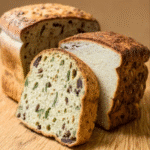If you’ve ever craved the comfort of bread but worried about your blood sugar, you’re not alone. For so many folks managing type 2 diabetes or insulin resistance, giving up bread can feel like saying goodbye to a warm memory. But guess what? You don’t have to. In this article, we’ll explore whether keto bread is good for diabetes, why it matters, and how you can enjoy it guilt-free. From personal stories in my Vermont kitchen to scientific insights and real-life tips, this guide is warm, thorough, and just what you need. Let’s jump in!

Table of Contents
Is Keto Bread Good for Diabetes? The Story Behind the Slice
What Inspired Me to Write About Diabetic-Friendly Keto Bread
It all started one snowy morning in Vermont. I remember watching my mom, strong and smiling, baking a simple loaf of her rosemary bread. It wasn’t keto, and it surely wasn’t low-carb, but it was made with intention and love. Years later, when I began crafting keto bread for diabetics, I aimed to capture that same heartwarming feeling — but with ingredients that wouldn’t cause sugar spikes.
For those living with diabetes, every bite matters. The carbs in just one slice of regular bread can send blood sugar soaring. So what if we could make bread that comforts without consequences? That’s exactly why many ask: Is keto bread good for diabetes? More people today are questioning whether is keto bread good for diabetes as a daily staple.
When I first started this journey, I often heard the question, is keto bread good for diabetes? It’s a natural concern since bread is such a beloved food. But the good news is, keto bread can be a real game-changer. By focusing on low-carb ingredients, we can answer with confidence that keto bread is good for diabetes and can fit nicely into a balanced diabetic diet.
Print
Ryo’s Homemade Rosemary Keto Bread for Diabetics
- Total Time: 35 minutes
- Yield: 1 small loaf (6 slices) 1x
Description
A cozy, low-carb rosemary keto bread inspired by Ryo’s Vermont kitchen—perfect for diabetics craving comfort without sugar spikes.
Ingredients
1 cup almond flour
3 tbsp ground flaxseed
2 eggs
1 tbsp chopped fresh rosemary
1 tsp baking powder
Pinch of salt
1 tbsp olive oil
1/4 cup warm water
Instructions
1. Preheat your oven to 350°F (175°C).
2. Mix almond flour, flaxseed, rosemary, baking powder, and salt in a bowl.
3. In another bowl, whisk eggs, olive oil, and warm water.
4. Combine wet and dry ingredients and stir until thick.
5. Pour the mixture into a parchment-lined mini loaf pan.
6. Bake for 30 minutes or until golden and firm to the touch.
7. Let the bread cool completely before slicing.
8. Serve with butter, eggs, or avocado.
Notes
This recipe is gluten-free, low in net carbs, and diabetic-friendly. For nut allergies, substitute almond flour with sunflower seed flour.
- Prep Time: 5 minutes
- Cook Time: 30 minutes
- Category: Keto Bread
- Method: Baking
- Cuisine: American
Nutrition
- Serving Size: 1 slice
- Calories: 180
- Sugar: 0g
- Sodium: 160mg
- Fat: 15g
- Saturated Fat: 2g
- Unsaturated Fat: 12g
- Trans Fat: 0g
- Carbohydrates: 4g
- Fiber: 2g
- Protein: 6g
- Cholesterol: 55mg
Keywords: keto bread, rosemary bread, diabetic bread, low carb bread
Why Regular Bread Is a Problem for People with Diabetes
The Carb-Sugar Connection
Most conventional bread—white, whole wheat, or multigrain—is rich in simple carbohydrates. These break down quickly into glucose, causing a fast rise in blood sugar. That spike often leads to a crash, and for someone with diabetes, that cycle isn’t just frustrating—it’s dangerous.
Hidden Sugars and Misleading Labels
Even “healthy” breads at the store often hide added sugars or high-glycemic grains. Some have molasses, honey, or even malt syrup, which sound natural but act like sugar in the body.
According to the American Diabetes Association, managing carbohydrate intake is essential for blood sugar control, which makes finding the right kind of bread a top priority. And so, many turn to ask: Is keto bread good for diabetes or just another trend? We’ll soon see why this question has more than one delicious answer. If you’ve felt confused in the bread aisle, wondering is keto bread good for diabetes, this section clears the fog.
What Is Keto Bread and How Does It Work for Diabetes?
Understanding Keto Bread Ingredients
Keto bread skips the refined flour and instead uses almond flour, coconut flour, psyllium husk, flaxseeds, and eggs. These ingredients are low-glycemic, high in fiber and healthy fats, which means they digest slowly and don’t spike blood sugar. That makes them perfect for anyone wondering: Is keto bread good for diabetes? Or better yet, can it become a reliable go-to?
Nutritional Breakdown: Low in Net Carbs, High in Hope
The magic of keto bread lies in its “net carbs” — total carbs minus fiber. A typical slice might have only 2-3g of net carbs, which makes it ideal for diabetics aiming to stabilize glucose levels. So yes, keto bread is good for diabetes, especially when made right. And if you’re tracking your macros, you’ll likely notice a difference.
Does Keto Bread Spike Blood Sugar?
In short: not usually. Because of its high fiber and fat content, diabetic-friendly keto bread tends to produce a gentler blood sugar response compared to standard breads. So again, the question arises: Is keto bread good for diabetes? The science leans toward yes, and so does my kitchen. The more I bake it, the more I’m convinced keto bread is good for diabetes when thoughtfully prepared.
Can Keto Bread Help People with Diabetes?
Top Benefits of Keto Bread for Diabetics
If you’ve been asking yourself, is keto bread good for diabetes? — you’re not alone. This question is central to many who want to enjoy bread without blood sugar worries. Let’s dive into why keto bread is good for diabetes and explore its top benefits that make it a smart choice for managing your health.
1. Helps Stabilize Blood Sugar Levels
One of the biggest reasons people ask is keto bread good for diabetes? is because they want steady blood sugar. Traditional breads often cause rapid spikes, but keto bread is different. Thanks to its low-carb, high-fiber ingredients like almond flour and flaxseed, it slows digestion and keeps blood sugar stable — exactly what diabetics need.
2. Supports Weight Management
Many wonder if keto bread is good for diabetes when trying to lose weight. The answer is yes. Keto bread’s combination of healthy fats and protein helps keep you full, reduces cravings, and supports weight loss — all key factors for better blood sugar control.
3. High in Fiber for Better Gut Health
Fiber is essential for glucose management, so asking is keto bread good for diabetes includes considering fiber content. Keto bread often contains fiber-rich ingredients like psyllium husk and chia seeds, which slow glucose absorption and promote gut health — a win-win for diabetics.
4. Keeps You Energized Longer
People often wonder, is keto bread good for diabetes because they want lasting energy without crashes. Thanks to healthy fats and protein, keto bread fuels your day steadily, helping avoid the sugar highs and lows common with regular bread.
5. Offers Comfort and Normalcy
Food is comfort, and many ask is keto bread good for diabetes because they miss traditional bread’s feel. Keto bread provides that joy without the sugar crash, letting you enjoy toast, sandwiches, or snacks guilt-free.
6. Low in Net Carbs
If you’re still questioning is keto bread good for diabetes, consider the carb count. Keto bread typically contains only 2-3 grams of net carbs per slice, making it perfect for keeping blood sugar balanced without sacrificing taste.
When Keto Bread Might Not Be Ideal
Now hold on — not all keto breads are created equal. While many of us love the idea, it’s fair to ask, is keto bread good for diabetes when it’s store-bought? The answer: it depends. Some brands include processed oils, artificial preservatives, or sugar alcohols that can upset sensitive stomachs. And not all low-carb breads are made with quality ingredients.
You also have to watch out for net carb math tricks. Labels might claim it’s keto-friendly, but still cause glucose fluctuations. So, if you’re asking, is keto bread good for diabetes across the board, the truth is—it’s only as good as what’s inside.
And if you’ve got nut allergies, then almond flour (a common keto ingredient) might not work for you. That’s why I love making my own loaves, like a cozy rosemary-infused version with sunflower seed flour—no worries, just warmth.
Ryo’s Pro Tips for Picking the Best Bread
- Always check the label. Look for no added sugars, clean ingredients, and fewer than 3g of net carbs per slice. Wondering is keto bread good for diabetes when it’s mass-produced? Not unless those labels check out.
- Avoid overly processed options. The fewer ingredients, the better the nutrition. Simpler is always safer.
- Pair smart. Top it with proteins and healthy fats—like avocado, eggs, or turkey—for a balanced bite that supports stable glucose.
So, is keto bread good for diabetes if you choose wisely and avoid sketchy brands? Absolutely. But you’ve got to read every label like you mean it—your body will thank you.
Can a Keto Diet (with Bread!) Support Type 2 Diabetes Management?
What the Research Says
Several studies show that a low-carb ketogenic diet can improve insulin sensitivity and even reduce or eliminate the need for medications. But moderation is key. If you’re wondering, is keto bread good for diabetes, remember: it’s not a magic fix, but it’s a helpful tool in a well-rounded plan.
Food Is Fuel—But Also Comfort
Living with diabetes isn’t just about numbers. It’s about balance. And when you find a food that feels both comforting and safe? That’s when healing begins. For many, keto bread is good for diabetes because it bridges taste and wellness.
Ryo’s go-to? A toasted keto rosemary slice with pasture-raised eggs and olive oil—simple, nourishing, and stabilizing. I’ve often said it aloud to myself while making breakfast: “Yes, keto bread is good for diabetes!”

Ryo’s Homemade Rosemary Keto Bread for Diabetics
A Cozy Vermont-Inspired Recipe
This one’s close to my heart. My mom used to bake rosemary bread every Sunday, and I wanted to keep that tradition—just keto-fied. And now it’s one more reason why I believe keto bread is good for diabetes when baked with love and clean ingredients.
Ingredients:
- 1 cup almond flour
- 3 tbsp ground flaxseed
- 2 eggs
- 1 tbsp chopped fresh rosemary
- 1 tsp baking powder
- Pinch of salt
- 1 tbsp olive oil
- 1/4 cup warm water
Instructions:
- Preheat your oven to 350°F.
- Mix dry ingredients in one bowl and wet in another.
- Combine and stir until thick.
- Pour into a parchment-lined mini loaf pan.
- Bake for 30 minutes. Let cool. Slice and enjoy!
It’s gluten-free, low-carb, and absolutely diabetic-friendly. Enjoy it warm with butter or a soft-boiled egg—you deserve it. And now you can say with confidence: Yes, keto bread is good for diabetes!
With love from Ryo’s kitchen — follow Fastryo on Facebook and let me know what you think!
FAQs About Keto Bread for Diabetes (with gluten-free & specialty options!)
What Bread Is Best for Diabetics?
Keto bread is a strong contender, but so is gluten-free bread made with almond or flaxseed flour. Sprouted grain bread can work too—just watch the net carbs. When in doubt, ask: Is keto bread good for diabetes compared to these? Often, the answer is yes.
Is Kamut Bread Good for Diabetics?
While kamut bread is more nutritious than white bread, it still contains too many carbs for strict blood sugar control. A small portion could fit a moderate plan, but again, keto bread is good for diabetes more consistently.
Can I Eat Panini Bread on a Keto Diabetic Diet?
Panini bread is usually high in carbs. But you can make a keto version at home with low-carb flour blends. I sometimes press my rosemary loaf into a panini — works like a charm!
Does Keto Bread Help Control Glucose Levels?
Absolutely, especially when part of a balanced keto lifestyle. The fiber and fats work together to slow digestion and sugar absorption. Keto bread is good for diabetes, particularly when eaten mindfully.
Can Diabetics Eat Bread Every Day?
Yes—as long as it’s the right bread. Choose keto, gluten-free, or low-glycemic versions. Remember: it’s not about deprivation; it’s about smart choices.
